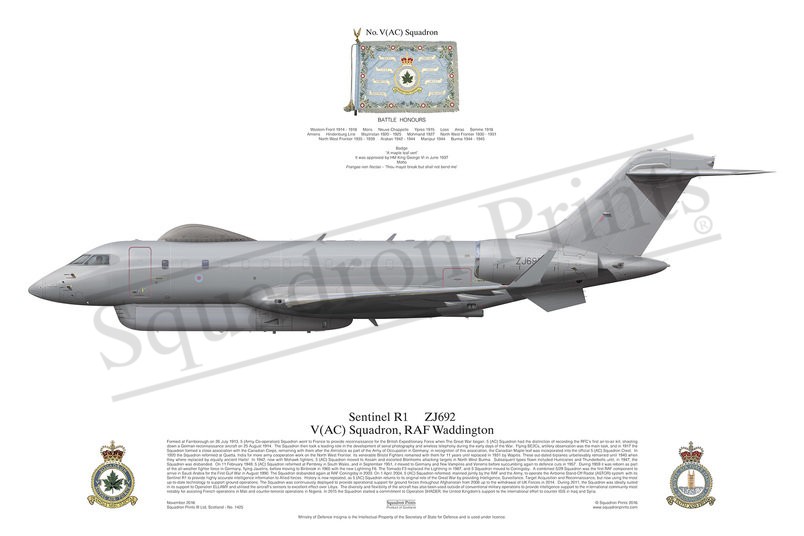#1425 Sentinel R1

Purchased products will not feature the Squadron Prints watermark
Description
Squadron Prints Lithograph No. 1425 - ZJ962, Sentinel R1, V(AC) Squadron, RAF Waddington.
Formed at Farnborough on 26 July 1913, 5 (Army Co-operation) Squadron went to France to provide reconnaissance for the British Expeditionary Force when The Great War began. 5 (AC) Squadron had the distinction of recording the RFC’s first air-to-air kill, shooting down a German reconnaissance aircraft on 25 August 1914. The Squadron then took a leading role in the development of aerial photography and wireless telephony during the early days of the War. Flying BE2Cs, artillery observation was the main task, and in 1917 the Squadron formed a close association with the Canadian Corps, remaining with them after the Armistice as part of the Army of Occupation in Germany; in recognition of this association, the Canadian Maple leaf was incorporated into the official 5 (AC) Squadron Crest. In 1920 the Squadron reformed at Quetta, India for more army cooperation work on the North West Frontier. Its venerable Bristol Fighters remained with them for 11 years until replaced in 1931 by Wapitis. These out-dated biplanes unbelievably remained until 1940 when they where replaced by equally ancient Harts! In 1942, now with Mohawk fighters, 5 (AC) Squadron moved to Assam and escorted Blenheims attacking targets in North West Burma. Subsequent types flown included Hurricanes and Thunderbolts until, in 1947, the Squadron was disbanded. On 11 February 1949, 5 (AC) Squadron reformed at Pembrey in South Wales, and in September 1951, it moved to Germany and flew Vampires and Venoms before succumbing again to defence cuts in 1957. During 1959 it was reborn as part of the all-weather fighter force in Germany, flying Javelins, before moving to Binbrook in 1965 with the new Lightning F6. The Tornado F3 replaced the Lightning in 1987, and 5 Squadron moved to Coningsby. A combined 5/29 Squadron was the first RAF component to arrive in Saudi Arabia for the First Gulf War in August 1990. The Squadron disbanded again at RAF Coningsby in 2003. On 1 April 2004, 5 (AC) Squadron reformed, manned jointly by the RAF and the Army, to operate the Airborne Stand-Off Radar (ASTOR) system with its Sentinel R1 to provide highly accurate intelligence information to Allied forces. History is now repeated, as 5 (AC) Squadron returns to its original role of the Great War by providing Intelligence, Surveillance, Target Acquisition and Reconnaissance, but now using the most up-to-date technology to support ground operations. The Squadron was continuously deployed to provide operational support for ground forces throughout Afghanistan from 2008 up to the withdrawal of UK Forces in 2014. During 2011, the Squadron was ideally suited in its support to Operation ELLAMY and utilised the aircraft’s sensors to excellent effect over Libya. The diversity and flexibility of the aircraft has also been used outside of conventional military operations to provide intelligence support to the international community most notably for assisting French operations in Mali and counter-terrorist operations in Nigeria. In 2015 the Squadron started a commitment to Operation SHADER, the United Kingdom’s support to the international effort to counter ISIS in Iraq and Syria.
You may also like
-
48th FW First USAFE Lightnings print
19-5495; 19-5493493 FS, 48 FW; 495 FS, 48 FWRAF Lakenheath -
SALE RAF Role Demo Signed Print 2008
8 Sqn; 100 Sqn; 43 Sqn & 111 Sqn; 2 Sqn; 18 Sqn
